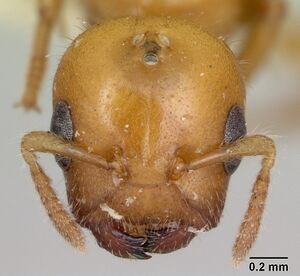Cladomyrma yongi
| Cladomyrma yongi | |
|---|---|

| |
| Scientific classification | |
| Kingdom: | Animalia |
| Phylum: | Arthropoda |
| Class: | Insecta |
| Order: | Hymenoptera |
| Family: | Formicidae |
| Subfamily: | Formicinae |
| Tribe: | Plagiolepidini |
| Genus: | Cladomyrma |
| Species: | C. yongi |
| Binomial name | |
| Cladomyrma yongi Agosti, Moog & Maschwitz, 1999 | |
Cladomyrmas yongi has only been collected in Drypetes longifolia in two localities in Sabah and Sarawak. In "pruning experiments" this species attacked soft young twigs of climbers experimentally placed on the host plant, often destroying the alien plant parts in contact with the host (Agosti et al. 1999, unpubl. results).
Identification
Agosti et al. (1999) placed Cladomyrma species into two groups based on the shape of the queen's petiole, raised (an erect node or scale) or depressed (dorsally truncate and low). Cladomyrma yongi belongs to the depressed petiole group.
This species is characterized in the queen caste by its small size and the light yellowish brown, bicolored coloration. The small body size might be a valid character, as the type series is part of a mature colony with many alate queens and workers. This species shares its host with Cladomyrma hobbyi, the latter being of close resemblance to C. yongi. However, C. yongi queen differs in its evenly yellowish brown color, head not bicolored with the genae lighter colored than the rest, and petiole in lateral view dorsally evenly rounded and not truncated.
Keys including this Species
Distribution
Distribution based on Regional Taxon Lists
Indo-Australian Region: Borneo (type locality), Indonesia, Malaysia.
Distribution based on AntMaps
Distribution based on AntWeb specimens
Check data from AntWeb
Countries Occupied
| Number of countries occupied by this species based on AntWiki Regional Taxon Lists. In general, fewer countries occupied indicates a narrower range, while more countries indicates a more widespread species. |

|
Estimated Abundance
| Relative abundance based on number of AntMaps records per species (this species within the purple bar). Fewer records (to the left) indicates a less abundant/encountered species while more records (to the right) indicates more abundant/encountered species. |

|
Biology
Castes
Worker
Images from AntWeb
   
| |
| Paratype of Cladomyrma yongi. Worker. Specimen code casent0173904. Photographer April Nobile, uploaded by California Academy of Sciences. | Owned by CAS, San Francisco, CA, USA. |
Queen
Images from AntWeb
   
| |
| Paratype of Cladomyrma yongi. Queen (alate/dealate). Specimen code casent0173905. Photographer April Nobile, uploaded by California Academy of Sciences. | Owned by CAS, San Francisco, CA, USA. |
Nomenclature
The following information is derived from Barry Bolton's Online Catalogue of the Ants of the World.
- yongi. Cladomyrma yongi Agosti, Moog & Maschwitz, 1999: 15, figs. 16, 28 (s.w.q.) BORNEO.
Unless otherwise noted the text for the remainder of this section is reported from the publication that includes the original description.
Description
Worker
Major: AL 0.88–0.92, HL 0.86–0.92, HW 0.69–0.78, EL 0.16–0.20, SL 0.38–0.42, CI 80–86, EI 22–27, SI 52–58 (n 5 8).
Small body size; clypeus angulate; metapleural gland orifice large; scattered hairs all over the body; hairs on propodeum not distinctly longer than those on the mesonotum; gastral pubescence short, appressed, and dense; body bicolored, with head and gaster distinctly darker than the yellowish brown alitrunk.
Minor worker. AL 0.66–0.70, HL 0.62–0.66, HW 0.48–0.54, EL 0.14–0.16, SL 0.30–0.36, CI 77–84, EI 26–31, SI 60–67 (n = 8).
Small body size; metapleural gland orifice large; scattered hairs all over the body; hairs on propodeum not distinctly longer than those on the mesonotum; gastral pubescence short, appressed, and dense; body bicolored with head and gaster distinctly darker than the yellowish brown alitrunk.
Queen
AL 1.80–2.06, HL 1.20–1.26, HW 0.92–1.00, EL 0.40–0.42, SL 0.56–0.60, CI 75–81, EI 40–45, SI 60–64. Holotype: Queen AL 1.86, HL 1.26, HW 0.94, EL 0.42, SL 0.60, CI 75, EI 45, SI 64. Holotype: Queen AL 1.86, HL 1.26, HW 0.94, EL 0.42, SL 0.60, CI 75, EI 45, SI 64.
Clypeus slightly angulate with the anterior face straight; head elongate in lateral view; genae same color as remainder of head; dorsal part of katepisternum punctulate and with thin pubescence; metapleural gland orifice large and open; petiole in lateral view quadrangular, dorsally evenly rounded with the posterior face gently sloped; whole body covered with long, erect hairs; gaster with short, widely set subdecumbent pubescence; gaster surface with silky shine; head and alitrunk evenly yellowish brown, gaster with at least the posterior parts of the tergites darker; small body size.
Type Material
E-MALAYSIA, Sarawak, Lambir NP, Miri, 2/26/1992, Brigitte Fiala, 92-240, ex: Drypetes longifolia; American Museum of Natural History. Paratype: E-MALAYSIA, Sarawak, Lambir NP, Miri, 2/27/1992, Ulrich Maschwitz, 92-234, ex: Drypetes longifolia, young colony; Sarawak, Lambir NP, Miri, 2/27/1992, Ulrich Maschwitz, 92-236a, ex: Drypetes longifolia; AMNH, Forest Research Institute Malaysia, Kepong, Los Angeles County Museum of Natural History, Museum of Comparative Zoology, Museo Civico di Storia Naturale, Genoa, Musee d'Histoire Naturelle Genève, The Natural History Museum, and the collections of Agosti and Maschwitz.
References
- Agosti, D., J. Moog, U. Maschwitz. 1999. Revision of the Oriental plant-ant genus Cladomyrma. American Museum Novitates. 3283:1-24.
- Cantone S. 2018. Winged Ants, The queen. Dichotomous key to genera of winged female ants in the World. The Wings of Ants: morphological and systematic relationships (self-published).
References based on Global Ant Biodiversity Informatics
- Agosti D., J. Moog, and U. Maschwitz. 1999. Revision of the Oriental Plant-ant genus Cladomyrma. American Museum Novitates 3283: 1-24.
- Pfeiffer M.; Mezger, D.; Hosoishi, S.; Bakhtiar, E. Y.; Kohout, R. J. 2011. The Formicidae of Borneo (Insecta: Hymenoptera): a preliminary species list. Asian Myrmecology 4:9-58

